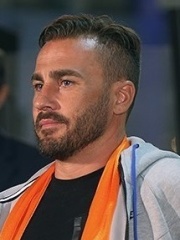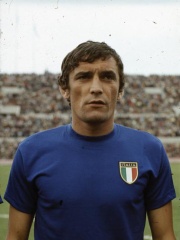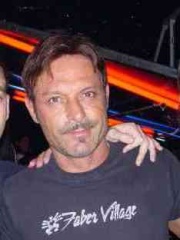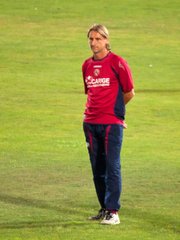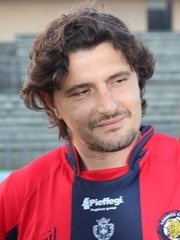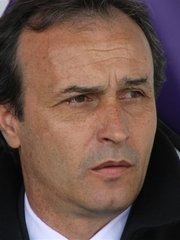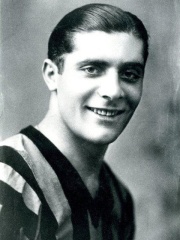







The Most Famous
SOCCER PLAYERS from Italy
This page contains a list of the greatest Italian Soccer Players. The pantheon dataset contains 21,273 Soccer Players, 739 of which were born in Italy. This makes Italy the birth place of the 7th most number of Soccer Players behind France, and Germany.
Top 10
The following people are considered by Pantheon to be the top 10 most legendary Italian Soccer Players of all time. This list of famous Italian Soccer Players is sorted by HPI (Historical Popularity Index), a metric that aggregates information on a biography's online popularity. Visit the rankings page to view the entire list of Italian Soccer Players.

1. Giuseppe Meazza (1910 - 1979)
With an HPI of 79.61, Giuseppe Meazza is the most famous Italian Soccer Player. His biography has been translated into 63 different languages on wikipedia.
Giuseppe Meazza (Italian pronunciation: [dʒuˈzɛppe meˈattsa]; 23 August 1910 – 21 August 1979) was an Italian football manager and player. Throughout his career, he played mainly for Inter Milan in the 1930s, scoring 284 goals in 408 games for the club, and winning three Serie A titles, as well as the Coppa Italia; he later also played for two seasons for local rivals Milan, as well as Turin rivals Juventus for one season, in addition to his spells with Varese and Atalanta. At the international level, he led Italy to win two consecutive World Cups: in 1934 on home soil, and in 1938 as captain, being named to the All-star Team. He is widely regarded as one of the best players of the 20th century, and one of the greatest Italian strikers in the history of the sport. Along with Giovanni Ferrari, Guido Masetti and Eraldo Monzeglio, he is one of only four Italian players to have won two World Cups. Following his retirement, he served as a coach for the Italy national team, and with several Italian clubs, including his former club sides Inter and Atalanta, as well as Pro Patria, and Turkish club Beşiktaş; he was Italy's head coach at the 1952 Summer Olympics. Due to his technical skill, prolific goalscoring, and creative ability, he was often given the nickname Il genio (The Genius) by the Italian press during his career. He has been ranked the fourth-best player in the history of the World Cup. A prolific forward, Meazza won the Serie A top-scorer award on three occasions in his career; with 216 goals in Serie A, he is the fourth all-time highest goal scorer in Serie A, alongside José Altafini, and with 33 goals, he is also the second highest goalscorer for the Italy national team. With 338 goals, he is the third-highest Italian goalscorer in all competitions. He is also the youngest player ever to score 100 goals in Serie A, a feat which he achieved at the age of 23 years and 32 days. San Siro, the principal stadium in his native city of Milan, which is today shared by two of his former clubs, Inter Milan and crosstown rivals A.C. Milan, was named Stadio Giuseppe Meazza in the player's honour on 3 March 1980. In 2011, he was posthumously inducted into the Italian Football Hall of Fame. Throughout his career, including friendlies, Meazza scored 552 goals.

2. Cesare Maldini (1932 - 2016)
With an HPI of 75.66, Cesare Maldini is the 2nd most famous Italian Soccer Player. His biography has been translated into 47 different languages.
Cesare Maldini (Italian pronunciation: [ˈtʃeːzare malˈdiːni, ˈtʃɛː-]; 5 February 1932 – 3 April 2016) was an Italian professional football manager and player who played as a defender. Father to Paolo Maldini and grandfather to Daniel Maldini, Cesare began his career with Italian side Triestina, before transferring to AC Milan in 1954, whom he captained to win four Serie A league titles, one European Cup and one Latin Cup during his twelve seasons with the club. He retired in 1967, after a season with Torino. Internationally, he played for Italy, earning 14 caps and participating in the 1962 World Cup. He served as team captain for both Milan and Italy. As a manager, he also coached his former club Milan on two occasions, as well as Italian sides Foggia, Ternana and Parma. He had a successful career in charge of the Italy under-21 side, winning the European Under-21 Championship a record three consecutive times; he later also coached the Italy senior team at the 1998 FIFA World Cup, and the Paraguay national football team at the 2002 FIFA World Cup.

3. Roberto Baggio (b. 1967)
With an HPI of 74.28, Roberto Baggio is the 3rd most famous Italian Soccer Player. His biography has been translated into 81 different languages.
Roberto Baggio (Italian pronunciation: [roˈbɛrto ˈbaddʒo]; born 18 February 1967) is an Italian former professional footballer who mainly played as a second striker, or as an attacking midfielder, although he was capable of playing in several offensive positions. He is the former president of the technical sector of the Italian Football Federation. A technically gifted creative playmaker and set piece specialist, renowned for his curling free-kicks, dribbling skills, and goalscoring, Baggio is widely regarded as one of the greatest players of all time. In 1999, Baggio came fourth in the FIFA Player of the Century internet poll, and was chosen on the FIFA World Cup Dream Team in 2002. In 1993, he was named FIFA World Player of the Year and won the Ballon d'Or. In 2004, he was named by Pelé in the FIFA 100, a list of the world's greatest living players. Baggio played for Italy in 56 matches and is the joint fourth-highest goalscorer for his national team. He starred in the Italian team that finished third in the 1990 FIFA World Cup. At the 1994 World Cup, he led Italy to the final, received the World Cup Silver Ball and was named in the World Cup All-Star Team. Although he was the star performer for Italy at the tournament, he missed the decisive penalty in the shootout of the final against Brazil. Baggio is the only Italian to score in three World Cups, and with nine goals holds the record for most goals scored in World Cup tournaments for Italy, along with Paolo Rossi and Christian Vieri. In 2002, Baggio became the first Italian player in over 50 years to score more than 300 career goals; he is the fifth-highest scoring Italian in all competitions with 318 goals. In 2004, during the final season of his career, Baggio became the first player in over 30 years to score 200 goals in Serie A, and is the seventh-highest goalscorer of all time in Serie A, with 205 goals. In 1990, he moved from Fiorentina to Juventus for a world record transfer fee. Baggio won two Serie A titles, a Coppa Italia, and a UEFA Cup, playing for seven different Italian clubs during his career (Vicenza, Fiorentina, Juventus, AC Milan, Bologna, Inter Milan, and Brescia). Baggio is known as Il Divin Codino ("The Divine Ponytail"), for the hairstyle he wore for most of his career, for his talent, and for his Buddhist beliefs. In 2002, Baggio was nominated Goodwill Ambassador of the Food and Agriculture Organization of the United Nations. In 2003, he was the inaugural winner of the Golden Foot award. In recognition of his human rights activism, he received the Man of Peace award from the Nobel Peace Prize Laureates in 2010. In 2011, he was the first footballer to be inducted into the Italian Football Hall of Fame.

4. Paolo Maldini (b. 1968)
With an HPI of 73.87, Paolo Maldini is the 4th most famous Italian Soccer Player. His biography has been translated into 76 different languages.
Paolo Cesare Maldini (Italian pronunciation: [ˈpaːolo malˈdiːni]; born 26 June 1968) is an Italian football executive and former professional footballer who played as a left-back or as a centre-back for AC Milan and the Italy national team. He is widely regarded as one of the greatest defenders of all time. As the Milan and Italy captain for many years, he was nicknamed "Il Capitano". Maldini held the record for appearances in Serie A (647), until he was surpassed by Gianluigi Buffon in 2020. He also holds the joint-record for most European Cup/UEFA Champions League final appearances (8) alongside Paco Gento. From 2018 to 2023 he worked at AC Milan as sporting director and is a co-owner of USL Championship club Miami FC. Maldini spent all 25 seasons of his playing career in Serie A with Milan and retired at the age of 41 in 2009. He won 26 trophies with Milan: the European Cup/UEFA Champions League five times, seven Serie A titles, one Coppa Italia, five Supercoppa Italiana titles, five European/UEFA Super Cups, two Intercontinental Cups, and one FIFA Club World Cup. Maldini won the Best Defender award at the UEFA Club Football Awards at the age of 39, as well as the Serie A Defender of the Year Award in 2004. Following his retirement, Milan retired his number 3 shirt. Maldini made his debut for Italy in 1988 and played for 14 years before retiring in 2002 with 7 goals and 126 caps. He held the record for appearances with Italy, until he was surpassed by Fabio Cannavaro and Gianluigi Buffon. Maldini captained Italy for eight years and held the record for appearances as Italy's captain (75), until he was again surpassed by Cannavaro and Buffon. With Italy, Maldini took part in four FIFA World Cups and three UEFA European Championships. Although he did not win a tournament, he reached the final of the 1994 World Cup and Euro 2000 and the semi-final of the 1990 World Cup and Euro 1988. He was elected into the all-star teams for all of these tournaments. Maldini came second to George Weah for FIFA World Player of the Year in 1995. He also came third in the Ballon d'Or rankings in 1994 and 2003. In 2002, he was named in the FIFA World Cup Dream Team. In 2004, Pelé named him in the FIFA 100 list of the world's greatest living players. He was ranked 21st in World Soccer magazine's list of the 100 greatest players of the 20th century. He was also named in the Ballon d'Or Dream Team in 2020. Maldini held the record for most appearances in UEFA Club competitions, with 174, until he was surpassed by Iker Casillas in 2017. He holds the record for appearances with Milan (902) and is one of the few players to have made over 1,000 career appearances. In December 2012, he was inducted into the Italian Football Hall of Fame.

5. Paolo Rossi (1956 - 2020)
With an HPI of 73.58, Paolo Rossi is the 5th most famous Italian Soccer Player. His biography has been translated into 63 different languages.
Paolo Rossi (Italian pronunciation: [ˈpaːolo ˈrossi]; 23 September 1956 – 9 December 2020) was an Italian professional footballer who played as a striker. He led Italy to the 1982 FIFA World Cup title, scoring six goals to win the Golden Boot as top goalscorer, and the Golden Ball for the player of the tournament. Rossi is one of only three players, and the only European, to have won all three awards at a World Cup, along with Garrincha in 1962 and Mario Kempes in 1978. Rossi was also awarded the 1982 Ballon d'Or as the European Footballer of the Year for his performances (remaining the only player in history to win these four awards in a single year). Along with Roberto Baggio and Christian Vieri, he is Italy's top scorer in World Cup history, with nine goals overall. At club level, Rossi was also a prolific goalscorer for Vicenza. In 1976, he was signed to Juventus from Vicenza in a co-ownership deal for a world record transfer fee. Vicenza retained his services, and he was the top goalscorer in Serie B in 1977, leading his team to promotion to Serie A. The following season, Rossi scored 24 goals, to become the first player to top the scoring charts in Serie B and Serie A in consecutive seasons. Rossi made his debut for Juventus in 1981, and went on to win two Serie A titles, the Coppa Italia, the UEFA Cup Winners' Cup, the UEFA Super Cup, and the European Cup. With success at club and international level, he is one of ten players to have won the FIFA World Cup, the UEFA Champions League and the Ballon d'Or. Widely regarded as one of the greatest Italian footballers of all time, Rossi was named in 2004 by Pelé as one of the Top 125 greatest living footballers as part of FIFA's 100th anniversary celebration. In the same year, Rossi placed 12th in the UEFA Golden Jubilee Poll. After he retired from football, he worked as a pundit for Sky, Mediaset Premium, and Rai Sport, until his death on 9 December 2020.

6. Filippo Inzaghi (b. 1973)
With an HPI of 73.00, Filippo Inzaghi is the 6th most famous Italian Soccer Player. His biography has been translated into 62 different languages.
Filippo "Pippo" Inzaghi (Italian pronunciation: [fiˈlippo ˈpippo inˈdzaːɡi]; born 9 August 1973) is an Italian professional football manager and former player who played as a striker. He is the head coach of Serie B club Palermo. Nicknamed "Superpippo" ("Super Goof") or "Alta tensione" ("High Tension") by fans and commentators during his playing career, Inzaghi is regarded as one of the greatest strikers of his generation. In the UEFA Champions League, he is the all-time Italian top goalscorer, scoring 46 goals. Inzaghi played for several Italian clubs and spent the most notable spells of his club career with Juventus and AC Milan, winning two Champions League titles (2003, 2007), and three Serie A titles (1998, 2004, 2011). He is the seventh highest scorer in Italy, with 313 goals scored in official matches. He is currently the sixth-highest goalscorer in European club competitions with 70 goals, behind only Cristiano Ronaldo, Lionel Messi, Robert Lewandowski, Raúl and Karim Benzema. He is also Milan's top international goalscorer in the club's history with 43 goals. He also holds the record for most hat-tricks in Serie A with 10. At international level, Inzaghi earned 57 caps for the Italy national team between 1997 and 2007, scoring 25 goals. He represented his country at three FIFA World Cups, winning the 2006 edition, and he also took part in UEFA Euro 2000, where he won a runners-up medal. His younger brother, Simone Inzaghi, is also a football manager and former Italian international player.

7. Francesco Totti (b. 1976)
With an HPI of 72.22, Francesco Totti is the 7th most famous Italian Soccer Player. His biography has been translated into 115 different languages.
Francesco Totti (Italian pronunciation: [franˈtʃesko ˈtɔtti]; born 27 September 1976) is an Italian former professional footballer who played solely for Roma and the Italy national team. He was a technically gifted and creative offensive playmaker who could play as an attacking midfielder or as a forward. Totti spent his entire career at Roma, winning a Serie A title, two Coppa Italia titles, and two Supercoppa Italiana titles. A prolific goalscorer, he is the second-highest scorer of all time in Italian league history with 250 goals, and is the seventh-highest scoring Italian in all competitions with 316 goals. Totti is the top goalscorer and the most capped player in Roma's history, holds the record for the most goals scored in Serie A while playing for a single club, and also holds the record for the youngest club captain in the history of Serie A. During his career at Roma, Totti has been referred to as Er Bimbo de Oro (The Golden Boy), Er Pupone (The Big Baby), L'Ottavo Re di Roma (The Eighth King of Rome), L'Imperatore (The Emperor) and Er Capitano (The Captain) by the Italian sports media. In 2013, the New York Times described him as a "Roman god in his game." Totti experienced global success on the world stage winning the 2006 FIFA World Cup and appearing in the finals of UEFA Euro 2000 with Italy. Totti was selected in the All-Star team for both tournaments; he also represented his country at the 2002 World Cup and Euro 2004. In 2007 due to recurring physical problems, Totti announced his international retirement to focus solely on club play with Roma. Regarded as one of the greatest players of his generation, and one of the greatest Italian footballers of all time, Totti won a record eleven Oscar del Calcio awards from the Italian Footballers' Association: five Serie A Italian Footballer of the Year awards, two Serie A Footballer of the Year awards, two Serie A Goal of the Year awards, one Serie A Goalscorer of the Year award, and one Serie A Young Footballer of the Year award. He also won the 2007 European Golden Shoe and the 2010 Golden Foot. Totti was selected in the European Sports Media team of the season three times. In 2004, he was named in the FIFA 100, a list of the world's greatest living players as selected by Pelé, as part of FIFA's centenary celebrations. In 2011, Totti was recognised by IFFHS as the most popular footballer in Europe. In 2015, France Football rated him as one of the ten-best footballers in the world who are over age 36. Following his retirement in 2017, Totti was awarded the Player's Career Award and the UEFA President's Award.

8. Silvio Piola (1913 - 1996)
With an HPI of 72.21, Silvio Piola is the 8th most famous Italian Soccer Player. His biography has been translated into 48 different languages.
Silvio Piola (Italian pronunciation: [ˈsilvjo ˈpjɔːla]; 29 September 1913 – 4 October 1996) was an Italian footballer who played as a striker. He is known as a highly prominent figure in the history of Italian football due to several records he set, and he is regarded as one of the greatest strikers of his generation, as well as one of the best Italian players of all time. Piola was part of the squad that won the 1933–35 Central European International Cup & the squad that won the 1938 FIFA World Cup with Italy, scoring two goals in the final, ending the tournament as the second-best player and the second-highest scorer. Piola is third in the all-time goalscoring records of the Italy national team. He is also the highest goalscorer in Italian first league history, with 290 goals (274 in Serie A and 16 in Divisione Nazionale), and also in Serie A history. He played 566 Serie A games, putting him fourth on the all-time list for appearances in Italy's top flight. Piola is the only player to have the honour of being the all-time Serie A top scorer of three different teams (Pro Vercelli, Lazio and Novara) Piola is also the highest scoring Italian player in all competitions, with 364 goals (391 if his goals in the Divisione Nazionale and for the Italy B team are also included). Throughout his career, including friendlies, Piola scored 682 goals. After his death, a pair of Italian stadiums were renamed after him: one in Novara in 1997 and another in Vercelli in 1998. In 2011, he was posthumously inducted into the Italian Football Hall of Fame.

9. Gianni Rivera (b. 1943)
With an HPI of 72.09, Gianni Rivera is the 9th most famous Italian Soccer Player. His biography has been translated into 52 different languages.
Giovanni "Gianni" Rivera (Italian pronunciation: [ˈdʒanni riˈvɛːra]; born 18 August 1943) is an Italian politician and former footballer who played as an attacking midfielder. Dubbed Italy's "Golden Boy" by the media, he played the majority of his club career with Italian side AC Milan, after beginning his career with hometown club Alessandria in 1959. After joining Milan in 1960, he enjoyed a highly successful career in domestic and European football, winning three Serie A titles and two European Cups, among several other trophies, and also serving as the team's captain for twelve seasons. At international level, Rivera represented Italy national team 60 times between 1962 and 1974, scoring 14 goals, and took part at four World Cups (1962, 1966, 1970, and 1974). Rivera is widely remembered for scoring the decisive goal in Italy's 4–3 extra-time win over West Germany in the semi-final of the 1970 World Cup, leading the team to final, only to suffer a 4–1 defeat against Brazil, however. Rivera was also a member of the first Italian side ever to win the European Football Championship in 1968, on home soil, and represented Italy at the 1960 Summer Olympics in Rome, helping the team to a fourth-place finish. Rivera was an elegant, efficient, and creative offensive playmaker, with an eye for goal, who possessed excellent vision and technical ability. Regarded as one of the greatest Italian footballers of all time, and by some as Italy's greatest player ever, he was awarded the Ballon d'Or in 1969, and placed 19th in IFFHS's election for the World Player of the 20th Century. In 2015, he became the first Italian footballer out of 100 athletes to be inducted into Italy's sports Walk of Fame. In 2004, Pelé chose Rivera as part of the FIFA 100 greatest living footballers, and he placed 35th in the UEFA Golden Jubilee Poll. After retiring from football in 1979, Rivera became Milan's vice-president and later went into politics in 1987. In 2013, he was appointed as President of the educational youth sector for the Italy national team by the FIGC, along with Roberto Baggio and Arrigo Sacchi, under head coach Cesare Prandelli. The Athletlic The Soccer 100 listed him at 68th greatest player ever. Following the death of Denis Law in January 2025, Rivera is currently the oldest living recipient of the Ballon D'Or.

10. Giacinto Facchetti (1942 - 2006)
With an HPI of 71.83, Giacinto Facchetti is the 10th most famous Italian Soccer Player. His biography has been translated into 50 different languages.
Giacinto Facchetti (Italian pronunciation: [dʒaˈtʃinto fakˈketti]; 18 July 1942 – 4 September 2006) was an Italian footballer who played as a left-back for Inter Milan from 1960 to 1978. He later served as Inter chairman from January 2004 until his death in 2006. He played 634 official games for the club, scoring 75 goals, and was a member of "Grande Inter" team under manager Helenio Herrera which won four Serie A titles, a Coppa Italia, two European Cups, and two Intercontinental Cups. He placed second for the Ballon d'Or in 1965. Facchetti represented Italy internationally on 94 occasions, including three FIFA World Cups. He was also elected to the 1970 World Cup All-Star Team, in which Italy were runners-up. He was also captain of the national side for a record 11 years that won Italy's first ever UEFA European Championship on home soil in 1968, where he was also elected to the team of the tournament. Facchetti is remembered as one of the first truly great attacking full-backs. He is regarded as one of the best football players ever at his position, due to his pace, technique, intelligence, physique, and stamina. He formed a formidable defensive partnership with fellow full-back Tarcisio Burgnich in Inter's defensive catenaccio system and with the Italy national side. In addition to his ability on the pitch, Facchetti was lauded for his discipline and leadership and captained both Inter Milan and Italy for several years. In March 2004, Pelé named him one of the Top 125 greatest living footballers as part of FIFA's 100th anniversary celebrations. In 2015, he was posthumously inducted into the Italian Football Hall of Fame.
People
Pantheon has 739 people classified as Italian soccer players born between 1886 and 2008. Of these 739, 593 (80.24%) of them are still alive today. The most famous living Italian soccer players include Roberto Baggio, Paolo Maldini, and Filippo Inzaghi. The most famous deceased Italian soccer players include Giuseppe Meazza, Cesare Maldini, and Paolo Rossi. As of April 2024, 61 new Italian soccer players have been added to Pantheon including Francesco Calzona, Cristiano Doni, and Giuliano Simeone.
Living Italian Soccer Players
Go to all RankingsRoberto Baggio
1967 - Present
HPI: 74.28
Paolo Maldini
1968 - Present
HPI: 73.87
Filippo Inzaghi
1973 - Present
HPI: 73.00
Francesco Totti
1976 - Present
HPI: 72.22
Gianni Rivera
1943 - Present
HPI: 72.09
Franco Baresi
1960 - Present
HPI: 71.68
Gianluigi Buffon
1978 - Present
HPI: 71.52
Fabio Cannavaro
1973 - Present
HPI: 70.68
Roberto Mancini
1964 - Present
HPI: 70.67
Sandro Mazzola
1942 - Present
HPI: 70.02
Simone Inzaghi
1976 - Present
HPI: 69.86
Antonio Conte
1969 - Present
HPI: 69.55
Deceased Italian Soccer Players
Go to all RankingsGiuseppe Meazza
1910 - 1979
HPI: 79.61
Cesare Maldini
1932 - 2016
HPI: 75.66
Paolo Rossi
1956 - 2020
HPI: 73.58
Silvio Piola
1913 - 1996
HPI: 72.21
Giacinto Facchetti
1942 - 2006
HPI: 71.83
Luigi Riva
1944 - 2024
HPI: 69.24
Salvatore Schillaci
1964 - 2024
HPI: 68.02
Gaetano Scirea
1953 - 1989
HPI: 67.66
Giampiero Boniperti
1928 - 2021
HPI: 67.54
Vittorio Pozzo
1886 - 1968
HPI: 67.52
Angelo Schiavio
1905 - 1990
HPI: 67.36
Gianpiero Combi
1902 - 1956
HPI: 67.34
Newly Added Italian Soccer Players (2025)
Go to all RankingsFrancesco Calzona
1968 - Present
HPI: 52.97
Cristiano Doni
1973 - Present
HPI: 51.70
Giuliano Simeone
2002 - Present
HPI: 49.14
Davide Nicola
1973 - Present
HPI: 49.10
Paolo Vanoli
1972 - Present
HPI: 48.52
Dario Bonetti
1961 - Present
HPI: 48.32
Michele Padovano
1966 - Present
HPI: 47.40
Michele Di Gregorio
1997 - Present
HPI: 46.56
Pasquale Marino
1962 - Present
HPI: 46.50
Massimo Crippa
1965 - Present
HPI: 46.19
Sergio Battistini
1963 - Present
HPI: 45.67
Massimo Mauro
1962 - Present
HPI: 45.56
Overlapping Lives
Which Soccer Players were alive at the same time? This visualization shows the lifespans of the 25 most globally memorable Soccer Players since 1700.



